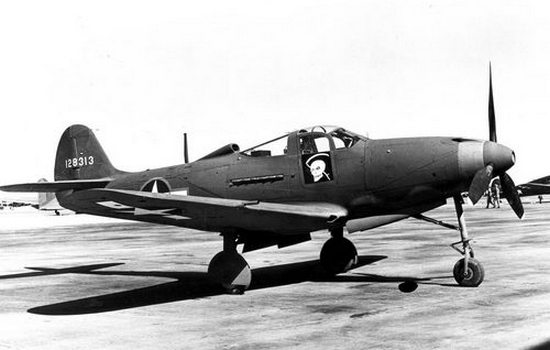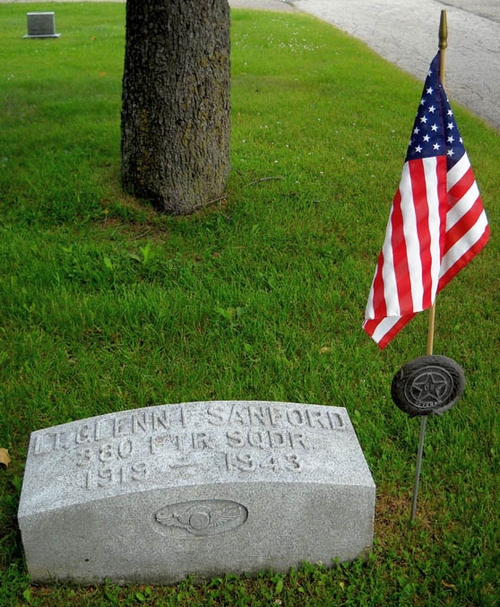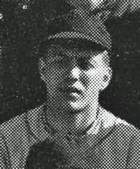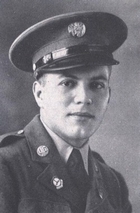Glenn Sanford
| Date and Place of Birth: | April 17, 1919 Clare, MI |
| Date and Place of Death: | November 6, 1943 Suisun Bay, CA |
| Baseball Experience: | Minor League |
| Position: | Pitcher |
| Rank: | Second Lieutenant |
| Military Unit: | 380th Fighter Squadron, 363rd Fighter Group USAAF |
| Area Served: | United States |
Glenn was a congenial young man with a pleasing personality
and a very promising future in his chosen field of baseball, and his
many friends join the family in their deep sorrow of today, which gives
promise of mellowing in the days to come with the knowledge that he gave
his all for the noble purpose of bringing justice and freedom again to
this earth that the generations to come may not know the grief of those
who will pay tribute to him.
Clare Sentinel, November 26, 1943
Glenn F. Sanford, the son of Dr. and Mrs. Frederick C. Sanford of
Clare, Michigan, attended Clare High School where he played basketball
and football, and was an outstanding left-handed pitcher who helped
guide the varsity team to the 1934 district tournament finals.
Sanford enrolled at Hillsdale College, Michigan, in September 1937, and
pitched for the varsity team his freshman year, attracting the attention
of Chicago Cubs scout, Dick Hallett. However, Sanford's father convinced
him to remain in school where he developed a reputation as an
outstanding athlete in baseball and basketball. "Sanford is regarded as
the number one hurler and has provided the students and fans with some
fine exhibitions of pitching," claimed the college yearbook.
His three-year college record included a no-hitter, a three-hitter, and
a 12-inning tie against Southern Michigan prison. Sanford also played
summer baseball with Post Products of Battle Creek, Michigan. The team
won the state amateur title in 1938 and went to the finals of the
National Amateur Tournament where they were beaten by Linden, New
Jersey.
In 1940, professional baseball came calling again in the form of the
Vancouver Capilanos of the Class B Western International League. This
time, Sanford could not resist and joined the team in Sunnyside,
Washington, for spring training. The Capilanos assigned him to the St.
Joseph Autos of the Class C Michigan State League where he pitched a
handful of games before joining the Fulton Tigers of the Class D May
League in June. Sanford posted a 14-9 won-loss record with a 4.02 earned
run average in sharing pitching duties with Rufe Gentry, who would go on
to win 12 games for Detroit in 1944.
Turning his back on professional baseball, Sanford volunteered for military service and was inducted into the Army on February 13, 1941, and while
serving with a coastal artillery battery at Camp Haan, California, he
often got the opportunity to limber up his pitching arm for the base
team. Late in the year, he applied for pilot training with the Army Air
Force and was released from service to await a position. He used the
time to make a return to minor league baseball and pitched for the Pittsfield Electrics of the Class C
Canadian-American League in 1942, appearing in six games
for a 2-4 record before beginning training as a fighter pilot. In 1943,
Sanford was awarded his wings and commissioned as a second lieutenant at
Yuma Advanced Flying School, Arizona, before being assigned to the 380th
Fighter Squadron of the 363rd Fighter Group, at Oakland Municipal
Airport, California.
On November 6, 1943, Second Lieutenant Sanford was flying a Bell P-39
Airacobra on a routine patrol along the California coast when there was
an engine explosion. The plane spiraled into the ocean at Suisun Bay,
about one mile east of Nichols, California.
Initially, Lieutenant Sanford was reported as missing to his parents. They received a telegram from the War Department on November 7 stating that he was missing in a maneuvers flight. On November 9, they received a telegram from Congressman Roy Woodruff detailing the crash. Sanford's body was eventually recovered on November 18.
"It is with deep regret that I have learned of the death of your
son," wrote Major General Barney M. Giles in a letter to Sanford's
parents. "The outstanding record that Lieutenant Sanford maintained
during his cadetship in the Advanced Flying School at Yuma Army Air
Field ... is one of which you can be justly proud. During his career as
a pilot, trustworthy and energetic performance of duty earned for him
the praise and confidence of his superiors, and with a sterling
character and high ideals he soon became a popular officer in his
group."
Glenn Sanford was cremated and his ashes returned to his hometown,
accompanied on the journey by Lieutenant Robert Stultz of Dayton, Ohio,
who had served with Sanford during the past year. He was buried at
Cherry Grove Cemetery with full military honors.
"I have been thinking a lot today of a boy I knew a few years ago,"
wrote the sports editor of the Fulton Daily Leader upon hearing about
Sanford's death. "Many Fulton people knew him well, for he was quite a
figure here during the 1940 baseball season ... and one of the cleanest
and most attractive boys who ever came here during the seven years the
Kitty League operated ... I do not recall seeing him get shelled out of
a game but one time, and that he came out with his head held high. It
was not his heart that failed that day, it was merely his arm refusing
to cooperate with his courage, and the next game he came right back with
a shutout ... I have a feeling that he met his final challenge the same
way."
Beginning in 1947, the Glenn F. Sanford Memorial Trophy was presented to outstanding Clare High School athletes.
|
Year |
Team |
League |
Class |
G |
IP |
ER |
BB |
SO |
W |
L |
ERA |
| 1940 |
St. Joseph |
Michigan State | C | 4 | 223.6 | - | 7 | - | 2 | 1 | - |
| 1940 |
Fulton |
Kitty | D | 26 | 197 | 88 | 90 | 119 | 14 | 9 | 4.02 |
| 1941 |
In Military Service |
||||||||||
| 1942 | Pittsfield | Canadian-American | C | 6 | 52 | 26 | 18 | 30 | 2 | 4 | 4.50 |

A Bell P-39 Airacobra. The type 2/Lt. Glenn
Sanford was flying when he crashed into the
Suisun Bay in California.

Glenn Sanford grave at Cherry Grove Cemetery in Clare, Michigan
Notes
1Hillsdale College Yearbook 1939
Utica Daily Press, August 21, 1942
Clare Sentinel, November 12 and 26, 1943
Letter from Major General Barney M. Giles to Mr. and Mrs. Sanford,
December 10, 1943
Fulton Daily Leader, March 8, 1944
Clare Sentinel, January 17, 1947
Thanks to Lola Sanford Blystone, Barbara Blystone, the Clare County Review and Linda Moore, Public Services Librarian at the Hillsdale College Mossey Library for all their help and support with this biography.
Date Added February 15, 2012 Updated June 8, 2014
Baseball's Greatest Sacrifice is associated with Baseball Almanac
Baseball's Greatest Sacrifice is proud to be sponsored by


